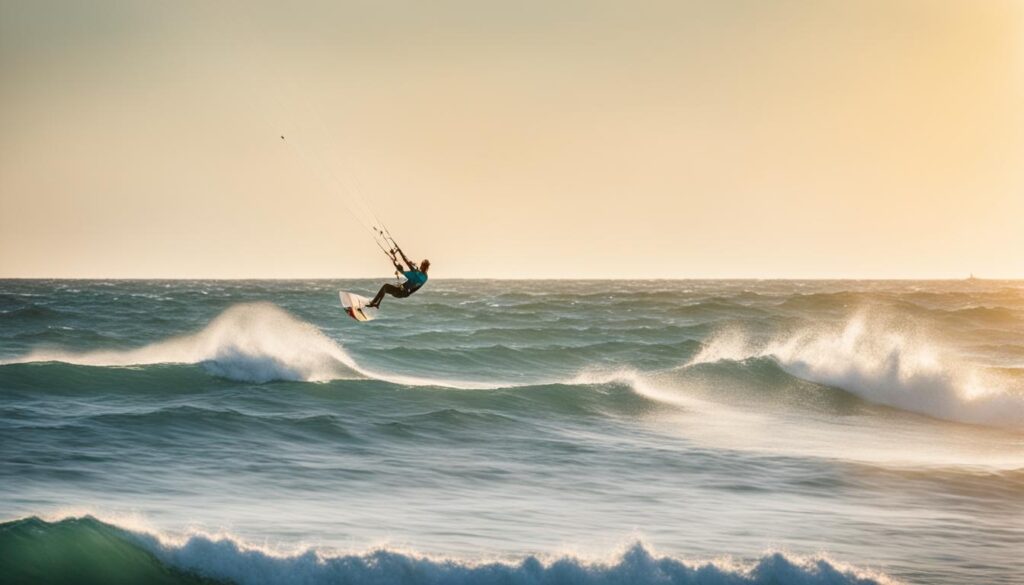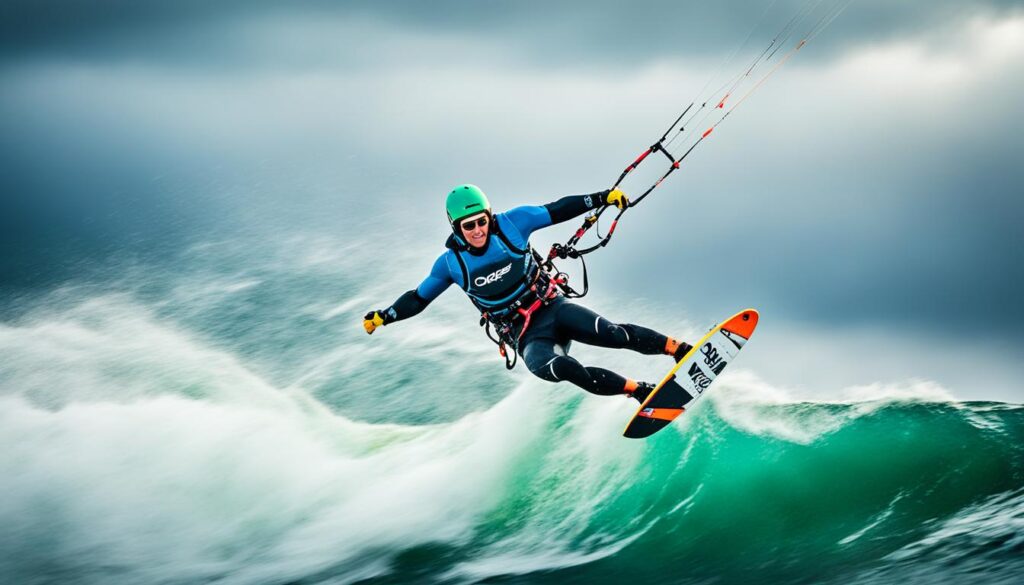Kitesurfing is more than just fun; it’s about changing with the wind. You need to adapt quickly to the wind’s changes. This is true for both new and experienced kitesurfers. Knowing how winds change your ride and making the right ride adjustment is key.
Get ready for an exciting adventure with kitesurfing techniques and kitesurfing tips. These will help you do better and stay safe on the water. Kiteboarding means listening to the wind. It tells you how to move your board and kite. Let’s learn how to adapt to kitesurfing and use any wind to our advantage.
Understanding the Wind: The Foundation of Kitesurfing
To be good at kitesurfing, you need to know about wind patterns and how to read the wind. This knowledge helps you use the wind safely and well.
Wind patterns and weather affect your kitesurfing a lot. By learning about wind zones, you can guess how your kite will do in different conditions. Using good forecasts helps you know when the wind might change. This makes your kitesurfing safe and fun.
Knowing how to read the wind is key. Paying attention to wind speed and direction helps avoid accidents and control your kite better. Learning about the Beaufort wind scale helps you understand wind conditions better.
It’s also important to know how the wind affects kite flying. The wind window is the safe area to fly your kite. Knowing about it helps you control your kite’s moves.
Putting these things into your kitesurfing will make you better and more happy with the sport. Every time you go out, you’re using what you know about weather and physics. This makes each kitesurfing session special and fulfilling.
Evaluating Your Kite and Board Selection
Choosing the right kitesurfing gear is key for fun and safety. It’s important to pick the right kite and board for the wind and what you need. Knowing how kite size and wind work together can make your time on the water better.
There are many kite types for kitesurfing, like inflatables and foil kites. Each has its own benefits for different winds. Big kites work well in light winds, while small ones are better in strong winds for control.
Boards also come in many types, such as twin tips, directional boards, and hydrofoils. Hydrofoils are great for light winds and help you glide easily. Twin tips work well in many wind conditions.
Having the right gear means having a “quiver” with many kites and boards for different winds. This lets you pick the best kite and board for the day. It’s all about making sure you’re set up right for the wind.
It’s also key to trust good brands and know what they offer. This helps you make smart choices and keeps your kitesurfing safe, no matter the weather.
Light Wind Kitesurfing: Techniques for Success
Learning to kite surf in light winds is both hard and rewarding. To do well, you need to know how to control your kite, ride upwind, and control your board’s edge. These skills help you have fun and make the most of little wind.

First, controlling your kite is very important in light winds. You must move your kite smoothly and keep it in the right spot. This stops it from losing power. Using special moves or adjusting the bar helps keep the kite steady.
Next, riding upwind is key to staying where you want and making the most of your time on the water. You need to position your kite just right and control your board well. By leaning back and digging your board into the water, you can go upwind even with little wind.
Also, controlling your board’s edge is crucial for your speed and direction. In light winds, you need to stand firm but be ready to move. Moving your body and changing your board’s angle helps you use the wind better.
Using these tips will make you better at kite surfing in light winds. It will also improve your overall skills. Embrace the challenge of light wind kite surfing and use these tips to make the most of it.
Strong Wind Kiting: Maximizing Control and Safety
Strong wind kitesurfing is fun but needs skill and safety steps. It’s key to know when to use kite depowering. This lets you control the kite’s power in strong winds.
Depowering the kite makes it easier to handle. It lowers the kite’s pull, helping you stay in control. This cuts down the risk of being blown away.

It’s important to adjust your gear for extreme winds. Pick a smaller kite and adjust your harness and lines. These changes help you stay safe and comfortable.
Wearing a helmet and impact vest is also a must. Always check the weather and be ready to change plans if needed. With these tips, you can kiteboard safely and have fun.
Strategies for Mid-Range Winds: Riding at Your Best
Mid-range wind kitesurfing is both a challenge and a chance for fun. It’s when winds blow between 15 to 25 knots. Here, you need to ride well and control your speed. Making the most of these winds is key.
To use mid-range winds well, keep a relaxed stance. Use the kite’s power with precise bar moves. Change your stance and technique as the wind shifts. This keeps you stable and in control.
Shifting your weight back on the board helps with sudden gusts or calm spots. This makes riding easier.
One great thing about kitesurfing in moderate winds is doing smooth moves and jumps. You can work on changing direction smoothly. Timing your jumps right can make you jump high and stay in the air longer.
Reading the wind and waves is important for a good session. Watching the water tells you about the wind. This helps you pick the best spots for big jumps or speed. With practice, you can improve your kitesurfing in mid-range winds.
Conclusion
Learning to kitesurf is more than just fun; it takes a deep understanding of nature’s forces. We’ve shared tips on how to adjust to the wind, helping you improve your skills. Each wind brings a new challenge that you can beat with the right knowledge and gear.
Picking the right gear and keeping safe can make a big difference. You can turn a scary storm into an exciting adventure. Learning to understand different winds helps you progress in kitesurfing. The tips we shared will help you surf with confidence, even on rough days.
As we end our journey, remember that getting better at kitesurfing never stops. With time and effort, you’ll learn to read the wind easily. Your skills will grow as much as the sea itself. Keep riding, and may the wind always be at your back.
